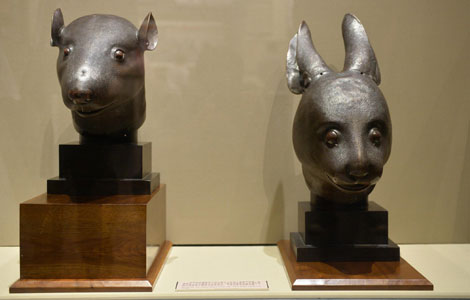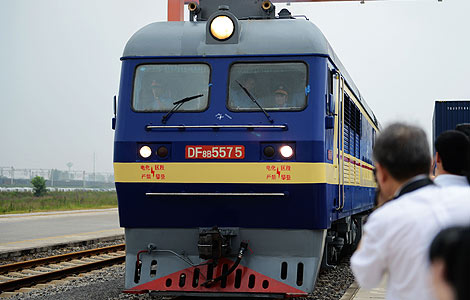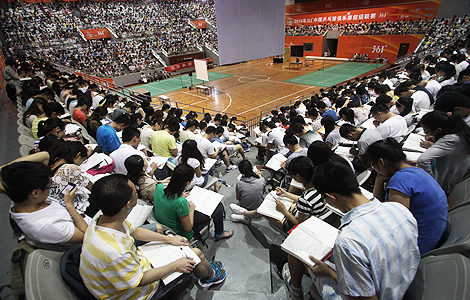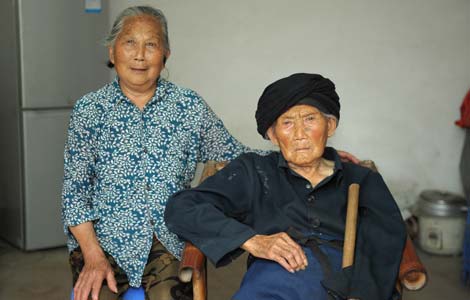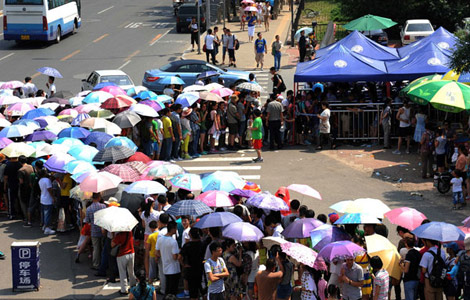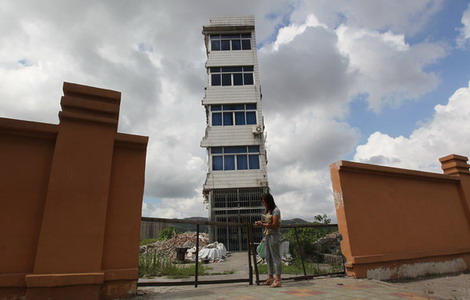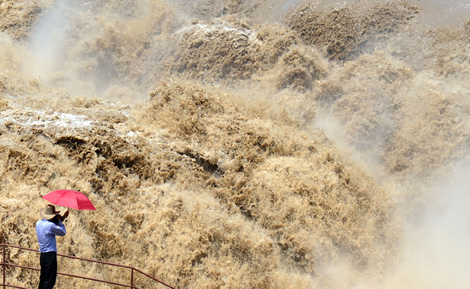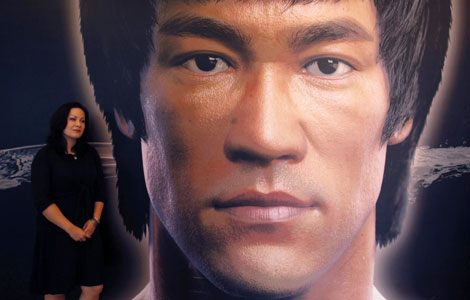

Heritage buildings reflect clan history, Zhang Yuchen reports from Hunan.
Song Huaiying feels content. His family's ancestral temple, after lying in ruins for 40 years, has been restored, enhancing clan unity and spiritual awareness.
 Ornamentation at ancestral temples in Rucheng county, include a stone lion and a wood carving at the Fan family temple in Yidao village and the paired stone drums that mark an entrance to the Li family temple in Tuqiao village. Photos by He Maofeng / for China Daily |
The Song temple in Dianhua village fell victim to marauders during the "cultural revolution" (1966-1976). Others met a similar fate or were displaced by land reform starting in the early 1950s. Now, hereditary buildings are rapidly appearing in the countryside.
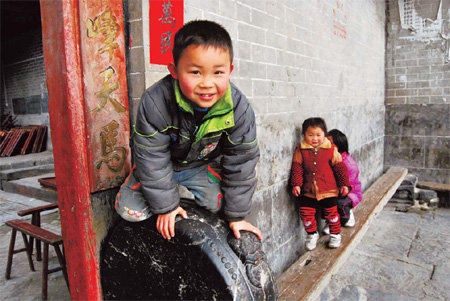 Children of Waisha village in Rucheng county like to play around the old ancestral hall. |
A recent study by Southwest University of Political Science and Law found that 107 of 285 clans have re-established their ancestral temples or revised records of family trees in Hunan, Guangdong, Fujian, Hainan, Jiangxi and Taiwan. "The spiritual reliance on the traditions of Chinese peasants will always endure," said lead researcher Xiao Tangbiao.
"Many elders in the village dream of the revival, too," said Song, who is in his 50s. "They have been yearning to worship our ancestors."
And now the people of Dianhua village, Rucheng county in Hunan province, have a newly restored, three-hall ancestral temple that is fronted by a shining, candy-apple red gate.
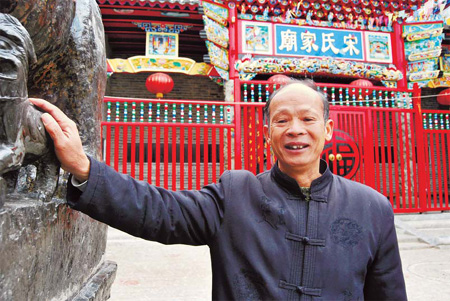 Song Huaiying poses in front of the Song temple that he and his fellow villagers rebuilt. |
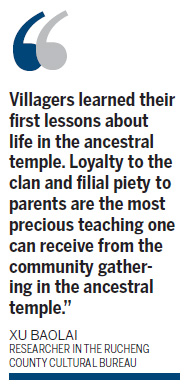
"It can be taken as a reflection of their reliving a sense of pride and belonging toward their own family and their longing for traditional values, which are essentials that society lacks nowadays," said He Shuzhong, founder of Beijing Cultural Heritage Protection Center.
The original temple, built about 600 years ago, once was a shrine to Song Jing (AD 663-737), who was considered one of four "virtuous" prime ministers during the Tang Dynasty (AD 618-907).
The importance of ancestral temples dwindled during much of the 1900s, but not for Song Huaiying. During the "cultural revolution," when he was 16, he'd heard about devastation of other temples and decided to check out his own. "I walked around inside and kept the whole picture of what it looked like in my mind."
The next day, only the structure remained, with nothing to indicate its ancient purpose. All of the traditional pictures had been ripped from the walls, he said. Gone, too, were the inscribed boards referring to the noble ancestors' achievements and the couplet scrolls with lucky sayings. Song remembered what he'd seen the day before "and hoped one day it might be re-established".
Keeping the old style
Old folks in the clan of 1,500 wanted to revive the temple but didn't have the money, Song said. Restoration became more of a possibility as China reformed and opened up, aided by the end of rural taxation in 2005 and, more recently, economic growth. By 2008, it was time to start fund-raising.
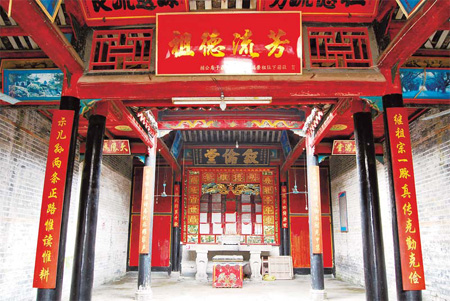 Inside the Lu family's ancestral hall in Jinshan village, Rucheng. |
Song had asked his elder brother, Song Qiaoying, and his younger brother, Song Daxiao - both of whom ran a successful tungsten mining business outside the village - and they were willing to help. Each villager donated 80 yuan, and Song's brothers paid most of the rest of the total cost: 1.4 million yuan ($213,700).
Song Huaiying supervised the whole course of the restoration, starting in 2009, in accordance with the old building style. He rejected the use of concrete or the fixtures found in modern, Western-style structures and instead collected slate and other old-style materials wherever he could find them.
Song took a five-hour trip by train to Guangzhou to buy gold decoration paper to paste on new paintings - an affordable alternative to inlay - on the back of the gate. He also found three old-style lanterns, and spent 55,000 yuan in all.
Song Huaiying hired skilled itinerant painters who specialize in old-style pictures to paint illustrations of ancient fairy tales or folk stories that include morality instruction.
One shows Chinese general and the tattoo on his back of his mother and the Chinese characters for jing zhong bao guo, meaning to serve your country with unreserved loyalty. The mother was teaching her son to be a righteous person by sacrificing for his country.
The painters also copied the destroyed portrait of Song Jing, the ancient prime minister, and Song Huaiying placed two candlesticks in front of the picture. Now, when visitors enter, the temple janitor immediately lights candles to show respect to the ancestor, as if the portrait were alive.
A site for first lessons
The functions of ancestral temples, even the new ones, have changed with time. "Now it is very difficult to find anyone who is familiar with the very old traditional formulation," said Chen Shizhou, who is in charge of old building preservation for the Rucheng county cultural bureau.
Previously, the memorial temple was a public place where the board of clan leaders announced decisions or judgment.
"It helped with the morality maintenance," said Liu Xiaojun, a civil servant working in Chenzhou, Hunan province. His remote, poor home village in Beihu district finished rebuilding its ancestral temple two years ago. "Sometimes," Liu said, "young people having made mistakes wouldn't accept the criticism unless elders pointed that out when the people of the whole clan got together in the temple."
"Villagers learned their first lessons about life in the ancestral temple," said Xu Baolai, researcher in the cultural bureau. "Loyalty to the clan and filial piety to parents are the most precious teaching one can receive from the community gathering in the ancestral temple."
Villager Huang Huaqin, who is in her 70s, told China Daily that 50 years ago when she married into the village, the temple has a sign that she was part of the family. "I am just glad to see it erected again," she said.
Now, the clan board owns no real decisive power and serves as an ad hoc committee when needed. It can be formed, for example, when issues such as rebuilding the ancestral temple have to be discussed, and then be dismissed as soon as the issue is resolved.
Many elders who are alone in rural areas like to get together, so some villages have turned their temples into a cultural or community center where the senior villagers can play mahjong or watch television. Or the heritage buildings have become sites for weddings and funerals.
"Some (villagers) take it in a very pragmatic way," said Chen, the building preservation leader. "For example, the family celebrating a marriage in the village has only to pay one yuan to rent each table in the wedding ceremony. That's very cheap compared to a restaurant."
Temples that once were used only by one clan now are open to people of different surnames. Anyone can go inside freely and look at postings of community information.
Out of this purpose, in some places the village leaders are very keen on attracting donations to the temple buildings. Liu, the Chenzhou civil servant, was the No 1 celebrity of his small hometown. When his village decided to build a memorial temple, he was persuaded to hand out 20,000 yuan as a contribution to the project.
As a reward, Liu was given the privilege of carving his name on the top of the list of donors on a stone board that was embedded into the temple's outside wall.
Debt repaid
Song was disappointed that village leaders didn't participate in the rebuilding project, but he said the village residents seemed pleased. They came on the day in January to celebrate the re-opening of the temple with fireworks lit at the temple's front gate.
The fireworks also marked the completion of Song Huaiying's dream. "I am feeling content that I got the chance to live it. Now I do not owe anything to my forebears."
